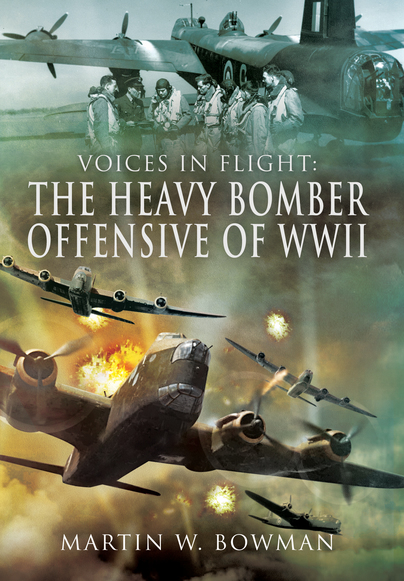
Voices in Flight: the Heavy Bomber Experience of WWII. By Martin W Bowman. Pen and Sword, Barnsley, 2015. Hardback 224 pages.
Reviewed by Tom Lewis
THIS is a collection of 14 stories from WWII, all of them about bombers flying from Britain against German targets. Voices in Flight is an interesting collection, wide-ranging enough to give something new to readers who have journeyed this way before, and comprehensive enough to engage the new explorer of a terrifying yet compelling theatre of battle conflict.
Aircrew members give full details of what their bomber experiences were actually like, as opposed to the expected and somewhat clichéd versions as given by movies. So we read of the pilot who admitted he once fell asleep and dived the aircraft thousands of feet before his anxious crew woke him up. He also wrote of diving the plane into cloud to escape an enemy night-fighter, only to discover it was a squashed fly on his windscreen, and of taking evasion moves twice in one night because he mistook the moon for an enemy aircraft.
Another chapter records the death of 14 men in one aircraft: the crew had offered to take several ground staff flying, and the weather got the better of them.
The earlier years of the war saw flying without the electronic aids which came later, to allow landings in fog, for example, and so we hear of 30 Whitley bombers which could not land after a raid, and so all the crew bailed out; all of the aircraft crashed, but all 150 aviators lived to tell the tale.
One chapter concerns an analysis of the stories of the famous novelist HE Bates. He wrote for the Air Ministry’s Public Relations Department, but these fiction-based-on-fact pieces he produced were not all gung-ho with brave and fearless fliers doing the business. Instead, and we are given many examples, they conveyed a sort of reality, with the tragedies and disappointments thrown in, but not the various outrages flying crews got up to; nor the occasional displays of what was in those days called “lack of moral fibre.” It would have been nice therefore to see an extract from one of Derek Robinson’s books such as Piece of Cake or Damned Good Show – a little satirical but researched with excellence and the added veracity of Robinson having served in the RAF in WWII.
There are several pages of good photographs, including one of a Stirling gun turret showing exactly the sort of damage which could be caused by an enemy fighter’s guns – the gunner was killed in the attack.
Unfortunately the text is marred by frequent proofreading – or rather, lack of proofreading – errors. Such as page 79, where “If” is rendered as “1f”, and in the preceding pages where several words are given capitals unexpectedly. Sometimes these errors are in the text of quoted interviews and/or transcripts, but even if they were in such sources the reader would expect to see “(sic)” after them to indicate that actually was the verbatim account. Some errors are weird: for example, as on page 136 – a strangely inserted hyphen six lines from the bottom of the page; and page 165 – a randomly inserted full stop in the second line of the third paragraph. Others look like being undetected errors from what may have been scanning of an old diary, for example an NCO advising a pilot on his parachute with the old joke: “If it doesn’t work, Sit, bring it back…” – where “Sit” is given instead of “Sir”, on page 193. Such errors are frequent and often annoying.
A major part of the narrative concerns the enemy opposition and its effectiveness. This consisted in the main of fighters during the day, at least until they became decimated by the sheer power of the Allies’ forces. Anti-aircraft fire was also formidable, but it seems from the stories that it was even more effective at night when it was combined with searchlights, and the dreaded “coning” ability of the lights and their relentless following of a caught bomber until it was blown out of existence by exploding shells. Night-fighters by comparison were not nearly so formidable.
There are also substantial sections which describe what happened when bombers were brought down. Crews spent days in small rubber boats, hoping to be picked up by their friends, or failing that, the enemy. Aircrew members parachuted out of their crippled aircraft to safety – sometimes – as often that was not the case, with landings in trees, roofs, or enemy positions.
The theme which unites all of these stories is the reality of them: the bravery of the crews, most of the time; and their failures when understandably they can’t cope; the acceptance of the need to fight to save their countries, their values, and their families and friends; the sturdiness of the aircraft involved, even those of dubious performance; and the relentless fear which gnawed away all the time on these bombing raids. It may not be true to say we will remember all of them forever, but it should be. Voices in Flight is recommended.



